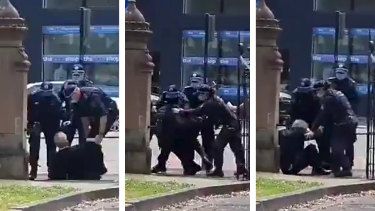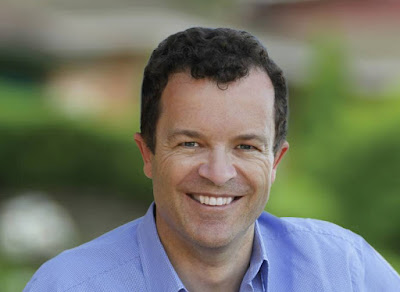USYD Law Professor Simon Rice "accidental arrest" : Was it in fact deliberate, and did NSW Police act on intelligence provided by USYD; Rev Dr Spence has not responded to story about USYD-NSW Police collusion
by Ganesh Sahathevan
Rev Dr Spence leaves in December should not be allowed to leave before answering
for his actions.The photo above by Honi Soit represents the sentiments of many at the way Spence changed the very character of the University
My accidental arrest amid a protest rally exposes a deeper concern: the abuse of state power
By Simon Rice
October 15, 2020 — 12.25pm
Last Saturday I joined a few thousand people on the sand at Coogee Beach. I was not arrested. On Wednesday I watched a couple of hundred university students marching around campus. I was arrested.
As we know from recent events, there is tension between protesting and COVID-safe distancing. On the one hand our society values the right to free speech and movement, and to express political opinion. On the other hand, we know that rights-limiting measures must be taken to protect public health.

I was grabbed from behind, and marched to a corner. My legs were kicked out from under me and I fell to my hands and knees.CREDIT:TWITTER/@HONI_SOIT
I went to watch the protest, to see how that tension would play out. I have some students researching the laws on protesting, and I suggested to them that they too might like to watch.
About 200 students marched around the University of Sydney, chanting slogans and waving banners to protest against the tertiary education reforms. For about 20 minutes I, with the police, followed them around the campus.
I was in the company of dozens of police on foot, at least four mounted police, and a number of police vehicles. As we walked around the campus, there was plenty of opportunity for the police to act if they were concerned about COVID-safe distancing.
The police didn’t act, and after a while I thought I was seeing a model resolution of the free speech/public health tension: students walking and chanting, and police standing by.
Then the students walked themselves into a bottleneck at the gates to Parramatta Road. They stopped, apparently unsure which way to go. I walked through them to get out the other side. It was bad timing.
Without an announcement or warning, or any apparent provocation, the police began physically restraining students, taking their banners and megaphones. Caught in this melee, and seeing what was happening, I asked some police why they were taking the students’ property. They didn’t answer.
I was grabbed from behind, and marched to a corner. My legs were kicked out from under me and I fell to my hands and knees. Trying to get up, I was pushed back down. Told I was under arrest, I was issued a fine for breaching the COVID Public Health Order.
There are issues here that are fundamental to the rule of law. One is consistency of law-enforcement. Citizens are entitled to know what the law is and when it will be enforced. People in Sydney, in large numbers and with a common purpose, go every day to a football match, the beach or a shopping centre without COVID-related police action.

Police clear protesting students from the road at Sydney University.CREDIT:RHETT WYMAN
The same people cannot, it appears, go on a peaceful protest march without risking arrest. The police may have a reason for this apparently inconsistent approach to COVID safety, but they need to explain it to us. Without an explanation, we can only speculate that police are choosing to suppress protest under the pretext of public health.
A second rule-of-law issue is proportionality. COVID safety or not, police are obliged to exercise state power in a reasonable, proportionate manner. That is not what I saw happen to others, or experienced myself. For a few moments, my arrest was bewildering and quite threatening. Getting arrested, let alone violently, was not on my bucket list. But I am a privileged arrestee. I have personal and professional resources to call on.
In the lives of so many, being surrounded by armed and aggressive police is a fact of life they deal with, often alone. It is a fact that most of my peers do not really appreciate, until they see it happen to one of their own.
The fact that I was violently arrested has confronted many for whom this is usually just another news story. It has alerted people to the way in which the police can and do use their power.
It is necessary that the state takes measures to protect public safety. But all use of state power must be consistent, proportional and suited to the purpose. What I saw failed this test.
Simon Rice is a professor of law at the University of Sydney.
Rev Dr Spence leaves in December should not be allowed to leave before answering
for his actions.The photo above by Honi Soit represents the sentiments of many at the way Spence changed the very character of the University
University Of Sydney (USYD) law professor Simon Rice wrote last week in the SMH about his "accidental arrest" (see story below). However, Sydney Criminal Lawyers (SCL) published previously evidence in the form of emails between Sydney University and NSW Police of USYD providing NSW Police intelligence on student protests. As reported on this blog, USYD Vice- Chancellor Rev Dr Michael Spence has yet to provide a response to the SCL story:
USYD's silence adds to the suspicion that Rice's arrest was intended by NSW Police, based on intelligence provided by USYD.
TO BE READ WITH
My accidental arrest amid a protest rally exposes a deeper concern: the abuse of state power
By Simon Rice
October 15, 2020 — 12.25pm
Last Saturday I joined a few thousand people on the sand at Coogee Beach. I was not arrested. On Wednesday I watched a couple of hundred university students marching around campus. I was arrested.
As we know from recent events, there is tension between protesting and COVID-safe distancing. On the one hand our society values the right to free speech and movement, and to express political opinion. On the other hand, we know that rights-limiting measures must be taken to protect public health.

I was grabbed from behind, and marched to a corner. My legs were kicked out from under me and I fell to my hands and knees.CREDIT:TWITTER/@HONI_SOIT
I went to watch the protest, to see how that tension would play out. I have some students researching the laws on protesting, and I suggested to them that they too might like to watch.
About 200 students marched around the University of Sydney, chanting slogans and waving banners to protest against the tertiary education reforms. For about 20 minutes I, with the police, followed them around the campus.
I was in the company of dozens of police on foot, at least four mounted police, and a number of police vehicles. As we walked around the campus, there was plenty of opportunity for the police to act if they were concerned about COVID-safe distancing.
The police didn’t act, and after a while I thought I was seeing a model resolution of the free speech/public health tension: students walking and chanting, and police standing by.
Then the students walked themselves into a bottleneck at the gates to Parramatta Road. They stopped, apparently unsure which way to go. I walked through them to get out the other side. It was bad timing.
Without an announcement or warning, or any apparent provocation, the police began physically restraining students, taking their banners and megaphones. Caught in this melee, and seeing what was happening, I asked some police why they were taking the students’ property. They didn’t answer.
I was grabbed from behind, and marched to a corner. My legs were kicked out from under me and I fell to my hands and knees. Trying to get up, I was pushed back down. Told I was under arrest, I was issued a fine for breaching the COVID Public Health Order.
There are issues here that are fundamental to the rule of law. One is consistency of law-enforcement. Citizens are entitled to know what the law is and when it will be enforced. People in Sydney, in large numbers and with a common purpose, go every day to a football match, the beach or a shopping centre without COVID-related police action.

Police clear protesting students from the road at Sydney University.CREDIT:RHETT WYMAN
The same people cannot, it appears, go on a peaceful protest march without risking arrest. The police may have a reason for this apparently inconsistent approach to COVID safety, but they need to explain it to us. Without an explanation, we can only speculate that police are choosing to suppress protest under the pretext of public health.
A second rule-of-law issue is proportionality. COVID safety or not, police are obliged to exercise state power in a reasonable, proportionate manner. That is not what I saw happen to others, or experienced myself. For a few moments, my arrest was bewildering and quite threatening. Getting arrested, let alone violently, was not on my bucket list. But I am a privileged arrestee. I have personal and professional resources to call on.
In the lives of so many, being surrounded by armed and aggressive police is a fact of life they deal with, often alone. It is a fact that most of my peers do not really appreciate, until they see it happen to one of their own.
The fact that I was violently arrested has confronted many for whom this is usually just another news story. It has alerted people to the way in which the police can and do use their power.
It is necessary that the state takes measures to protect public safety. But all use of state power must be consistent, proportional and suited to the purpose. What I saw failed this test.
Simon Rice is a professor of law at the University of Sydney.



Comments
Post a Comment